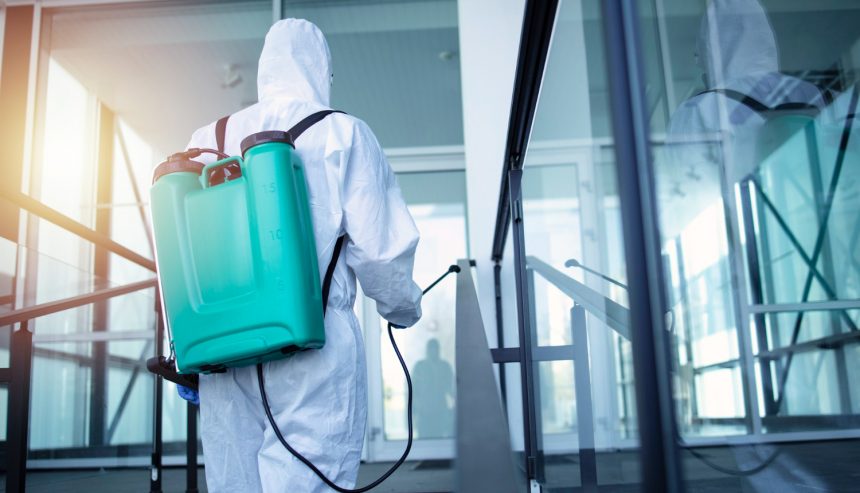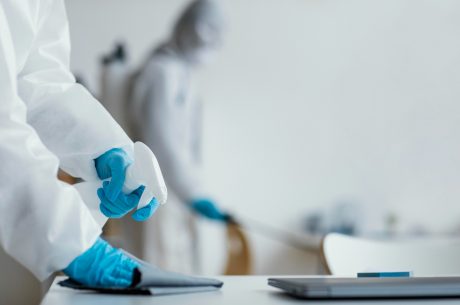Handling biohazard cleaning is no simple task. Whether it’s dealing with blood, bodily fluids, or chemical spills, effective biohazard cleaning is vital for the safety of your home or business. In Michigan, where industrial activities and daily life blend into one, the importance of maintaining a clean and safe environment cannot be overstated. Imagine facing a situation where someone has experienced a minor injury at a commercial site, leading to an unexpected need for biohazard cleaning. Knowing how to respond can prevent further contamination and keep everyone safe.
Addressing biohazards improperly can have serious consequences. Health risks abound, and improper handling can lead to more extensive contamination issues. When navigating these situations, having the right information on handling biohazard cleaning offers peace of mind. In this guide, you’ll learn a structured approach to dealing with such challenges, ensuring safety and health for all.
Step 1: Identify the Biohazard
Understanding what constitutes a biohazard is your first step. Biohazards include materials that pose a risk to human health, like:
– Blood and bodily fluids
– Human and animal waste
– Chemical substances
– Viruses and bacteria
Spotting these hazards involves a keen eye and awareness. Consider a simple paper cut in a public office setting—the resulting blood can be a concern if not managed correctly. Recognizing such situations quickly helps in deciding the cleaning procedure suitable for each type of biohazard.
Different biohazards require different handling approaches. Blood and bodily fluids, for instance, need disinfectants that can neutralize harmful pathogens. On the other hand, chemical spills might need specific neutralizers and safety equipment. This knowledge is key to safe and effective biohazard management, ensuring you tackle everything the right way from the start.
Step 2: Secure the Area
Once a biohazard is identified, securing the area becomes the next task. Begin by isolating the affected area to prevent people from accidentally entering and spreading the contamination further. Here’s a simple process to follow:
1. Set up barriers: Use cones or hazard tape to block off the area, alerting others to stay clear.
2. Notify others: Inform those nearby of the potential danger so they avoid the area until it’s cleaned.
3. Ventilate if needed: If the biohazard involves fumes or airborne particles, opening windows to allow fresh air flow can help reduce any dangerous exposure.
These steps help contain the situation, making it easier to manage. For example, imagine a small office spill – without proper signage, someone can easily walk into the area and spread the biohazard unintentionally. Safeguarding the premises ensures everyone’s safety and controls the contamination effectively.
Step 3: Use Proper Protective Gear
Getting ready with the right protective gear is your shield against exposure to harmful biohazards. Wearing gear like gloves, masks, and eye protection is crucial for safety. Think of a simple mask and gloves as barriers between you and potential health risks. This isn’t just about ticking boxes; it’s about ensuring that skin isn’t exposed and you’re not breathing in anything harmful.
Using the proper gear can prevent direct contact with hazardous materials. For instance, while dealing with blood or chemicals, the right gloves prevent skin irritation or infection. Similarly, masks act as a safeguard by preventing inhalation of harmful particles—key in maintaining your safety.
Remember, gear needs checking before use. Look for any tears or defects, especially in gloves and masks. Proper disposal after use is equally vital. Place them in a sealed bag to ensure no secondary contamination occurs. Taking these steps gives you confidence in handling biohazards, protecting both you and those around you.
Step 4: Clean and Disinfect
Now it’s time to clean and disinfect the area. This step demands the right cleaning agents and techniques. Start by removing waste and debris carefully, using tools that can be disposed of afterwards. Consider cleaning as a process of pouring water over a muddy surface until it runs clear—patience and thoroughness are your allies here.
Disinfecting needs specific products that address the biohazards you’ve identified. Check product labels to make sure they’re effective against the contaminants you’re facing. Use them according to instructions, as improper dilution might lead to inadequate decontamination or damage to surfaces.
During this process, focus on detailed cleaning. Reaching corners and hidden spots ensures no biohazard traces are left behind. After cleaning, make sure the area is left to air dry, as this allows chemical agents to complete their action effectively.
Step 5: Contact Professional Biohazard Cleaning Services
While doing some parts yourself can be feasible, professional services offer depth in cleaning that’s hard to replicate. Professional teams carry specialized training and equipment capable of handling complex biohazards. They don’t just clean; they assess and remediate areas in ways that ensure complete safety.
In Michigan, these services come in handy due to varied environmental factors and regulations. Professional cleaners can navigate these waters with ease, ensuring compliance and thorough rehabilitation of affected areas. They provide peace of mind, knowing your space is restored to safe conditions.
Professional help means dealing with the unseen, things we might overlook in regular cleaning. Consider them as the cleanup crew that comes in after the party, ensuring every corner is spotless and ready for the next day. Trusting experts puts you at ease and guarantees your home or business remains a safe environment.
Maintaining Safety and Cleanliness
Keeping your living or working space safe means following these structured steps for biohazard cleaning. Each action—from identifying hazards to securing assistance—contributes to a healthier environment. It’s about reducing risks and ensuring peace of mind in situations that could otherwise be daunting.
Remember, the takeaway here is clear: protect yourself, use proper gear, clean thoroughly, and rely on professionals when needed. With careful practices, you can handle biohazard situations effectively and ensure your space remains a safe haven for everyone.
To ensure a thoroughly safe environment, consider the benefits of professional biohazard cleaning services in Michigan. With specialized expertise and state-of-the-art equipment, PuroClean of Bloomfield Hills can effectively manage and decontaminate affected areas. Trusting experts means you’re taking a step towards a healthier, safer space for everyone. Find out more about our comprehensive biohazard cleaning services.




 PuroClean of Bloomfield Hills
PuroClean of Bloomfield Hills